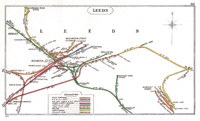LNER Restaurant Cars
Catering was an integral part of the principal expresses and we gave it a sub-chapter in "LNER Passenger Trains and Formations, The Principal Services", but space only allowed six portrait illustrations. Even Michael Harris in his last book could only fit in four pictures, so this will be extra material, trying not to repeat what's already out there. The sequence is now:
RF - 1st Restaurant RU - Unclassed Restaurant RC - 1st/3rd Restaurant Composite RC & RK - Ex-GNR 12w RC and conversion to Kitchen Cars
.. with some modelling stuff thrown in.
Revised caption and new addition placed here temporarily.
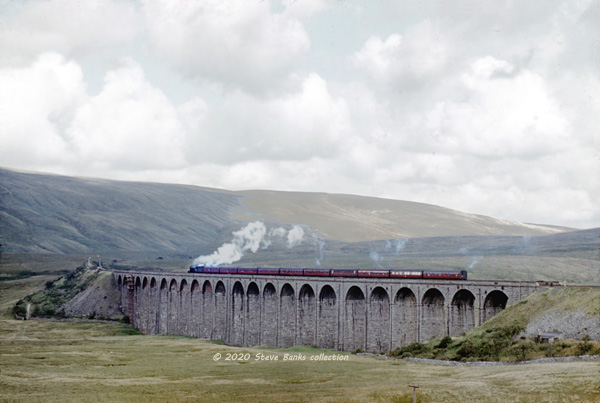
A view at Ribblehead Viaduct on 5th September 1960 with an unidentified A3 hauling a northbound express. This was the time when Holbeck was given A3s to work the Settle & Carlisle route, mostly the "Thames-Clyde". Note how on the rising gradient of 1:100 and 13 coaches behind the tender, the safety valves are blowing off!
And how the two catering carriages have been placed at the end of the train, a common practice if not much fun for passengers from the far end of the train who had to work their way though up to twelve carriages to get there. Photo: author's collection.

This enlargement is probably overdoing things although it shows all the carriages - BR Mk.1 with two ex-LNER - and how the catering pair (RF,SO) was added to the rear of the train:
- second from last is a Gresley 1st Restaurant (RF), the windows on the teak panelled body to D.10C or D.144 (see the Diagrams below) catching the light unlike the Mk.1 coaches on either side and looking as if they had been whited out. - on the rear is a well-patronised BR Mk.1 SO or TSO - note how the 1st and 2nd class dining areas have been positioned on either side of the kitchen.
Click on the images for an enlargement
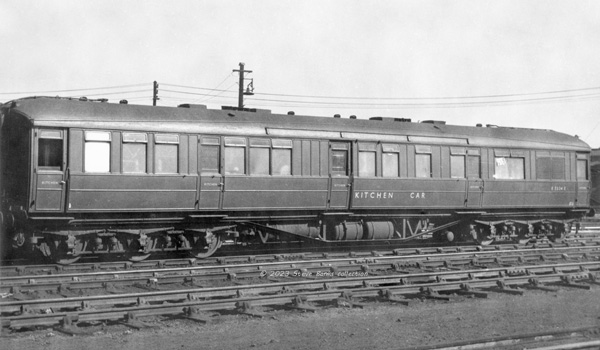
Another picture has come to light of the three ex-GNR 12w RC to GN.60 (see below), one of which was used in the LNER Newcastle-Bournemouth, until converted into kitchen cars (RK) for use with guaranteed excursions. There is much confusion in this area, notably by Longworth, and this one is believed to have been GN 3040 then LNER 43040 and as an RK, 2334, and is finally seen in BR maroon livery E23202E lasting until 11/60. Photo: author's collection.
Click on the image for an enlargement
The LNER 1st Restaurant car
We move on now to the most numerous type of of restaurant car built by the LNER. Much has already been published by Michael Harris, Clive Carter and myself, that restaurant cars like this were not a self-sufficient, stand-alone vehicle: they only catered for 1st Class passengers - 3rd Class passengers were served in an adjoining 3rd Open Dining Car, or the Pantry 3rd version.
Two- and three-car arrangements were normal, there was even one with four cars! And of course, the articulated triplet version with a kitchen car (described separately, see link below) for the heaviest trains. More restaurant and dining cars were built by Thompson. Modellers who wish to run an express with a normal restaurant service seem to struggle with this practice, yet even the shortest express formation, with 5 coaches, would contain a Restaurant Car + Dining Car pairing. If you want restaurant catering in your train the real question is what to choose to go with the RF?
- a 48-seat 3rd Open Dining car (with 2:1 seating and more generous tables)
- or the similarly spaced but more glamorous Pantry 3rd (because it had a pantry buffered next to the kitchen in the RF and the the LNER branded it "Restaurant Car". Dining FOs were branded the same so that many expresses ran with 2 or 3 carriages proclaiming a restaurant service. And it looks grand, too!
Don't be fooled by the eventual drift towards buffet and cafeteria car, nor by today's "trolley service". Things really, really used to be different! Clive and I showed many examples in the LNER Passenger Trains etc book and rather than repeat, here's a look at the LNER's development of the 61'6" 1st Restaurant car.
Developments
An important feature to bear in mind is that all carriage design evolved. On the LMS, for example, three distinct "Periods" have been identified. On the LNER the outward appearance may have looked the same but new features were introduced more or less constantly and slipped in unobtrusively. And it was the practice not to redraw a Diagram unless the body was altered significantly, a grey area of course. Many changes (such as the type of trussing), were not shown while production of an established design continued. (I may have said before that Diagrams are not as reliable a source as people may think)! Another complication when looking at restaurant cars, especially 1st class ones, was features particular to the class, such as toplights with Stones angled ventilators rather than sliding ones (they allowed air to be blown in as well as sucked out of the carriage), and they were built in smaller numbers which, if focussed on over a significant period of time, had the effect of making the changes more pronounced.
From D.10 to D.144
The 18-seat RF was established soon after the Grouping and construction for general service proceeded until mid-1936, followed a few years later by the Thompson version. The general theme under Gresley is represented very well by two kits:
MJT - based on the D.10 series (D.10C to be specific) because it is the most typical and had the longest life span. Stones ventilators were fitted in the dining saloon and turnbuckle trussing.
Kirk - the D.144 version had recessed doors and, from 1934, steel angle trussing. There was more variability in the toplights and vents, as the sample illustrations will show.
As always the illustrations are in chronological order of when built:
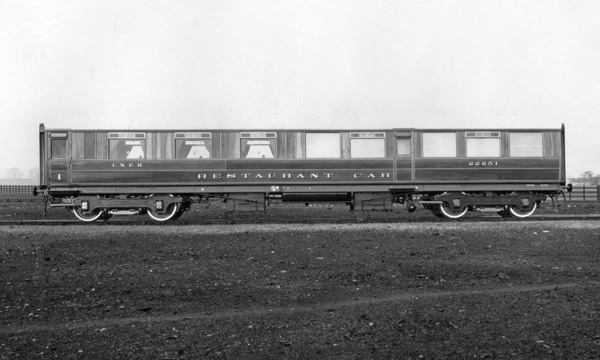
The first illustration blows the myth that Gresley starting building the "standard" RF in the D.10-D.144 series with electric cooking. In fact the first three diagrams - D.10, D.10A. D.10B had gas cooking. Here is, as built in 1925, No 22251 to D.10. It was the first and may be described as a prototype. Trussing was the turnbuckle type, to be fitted for another ten years, with a centrally placed gas cylinder and a pressure gauge on the solebar. At this stage, the vestibule at the dining end was deep with shelves; a cloakroom, you could say. All these features were to be replaced by new developments. Photo: LNER, author's collection.
Click on the image for an enlargement

The second picture shows an example of D.10C in which the basic layout was settled. This is No 43040 of 1928 built for services out of King's Cross. The deep vestibule and gas cooking have gone and three dynamos help feed many more battery boxes. Stones ventilators remain in the dining area and, at first glance, it looks like the same in the corridor but they are actually simpler, shallow sliding ventilators. And every corridor window was ventilated. Note how the screening on the windows did not obscure the quarter-lights so that staff could always look out. Author's collection.
Click on the image for an enlargement
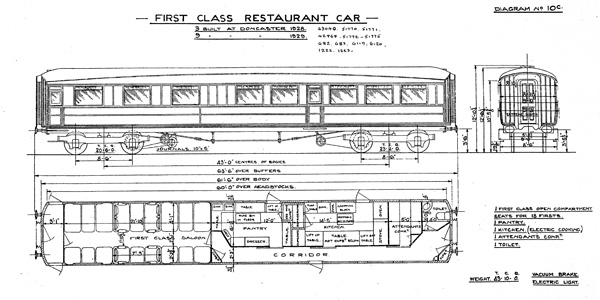
The only known issue of D.10C refers to a total of 12 built (1928-29), but actually shows all 14 numbers built in those years. The toplights shown are Stones (shallow) at the dining saloon, and 4 (shallow) sliding in the corridor. This tallies with the photograph of No 43040 (shown above) and the kitchen side of No 6119 (1929). Author's collection.
Click on the image for an enlargement
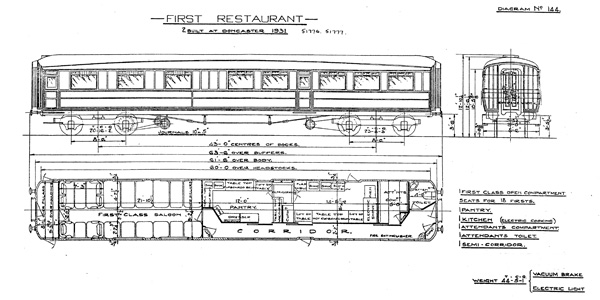
The drawing for D.144 is very similar to D.10C above and also only known in a single issue. It carries the numbers of two of the first four built, in 1931. Visible differences externally are in the recessed doors, but also in the corridor toplights which were 3-shallow, which was quite short lived. I'll have a bit more to say when I describe some of the models; for now I'm trying to set out some markers and point us in a direction that is based on the real thing. Author's collection.

No 42788 of 1931 was one of that first quartet to D.144 and also built for services out of King's Cross and is seen here in BR days in b&c livery and running number of E9069E. Note that turnbuckle trussing was still being fitted and Stones vents in the dining area, and shielded ventilators over the small, kitchen windows. Photo: A.G. Ellis, author's collection.
Click on the image for an enlargement

Another step along the way is shown by this D.144 built in 1935. Originally No 654 for the GE Section, now in BR maroon and No E9074E, the penultimate version can be seen with steel angle trussing, deeper Stones vents for the dining saloon and for the kitchen, deep sliding ventilators. Was there a series of hot summers in the 1930s that nudged the LNER towards ever more efficient ventilation for its staff and passengers? Whatever the reason, there is a distinct difference in ambience between types built only a few years apart. The final year, 1936, saw yet more change as 4-square sliding ventilators were fitted all round. On the LMS this might have been a "Period III" design and it was certainly precursor to Thompson carriages; but on the LNER change was more continuous and, to a large degree, under-appreciated.
A significant step lay in fitting of ventilators in all corridor windows of gangwayed carriages from 1938, which had been achieved in restaurant cars some ten years earlier! Photo: BR, author's collection.
Click on the image for an enlargement
In service

D21 4-4-0 No 1246 in the 1920s swings round the curve on the approach to Kirkham Abbey station between Scarborough and York with a long express, possibly an early version of the "Scarborough Flier". The D21s were the most powerful of the ex-NER 4-4-0s and would hand over at York to a Pacific for the non-stop run to King's Cross.
Catering is being provided by a classic pair of RF+TO with the restaurant car to D.10C and the dining car from the D.27 series (both produced by MJT). Photo: author's collection.
Click on the image for an enlargement

This view from c1958 on the ECML shows V2 No 60889 (DON) with an Up express, possibly a relief because so few destination boards are being carried.- there could be ten trains like this on a summer Saturday and the coaches are a 50:50 mixture of Gresley and BR Mk.1 in carmine & cream and maroon liveries. The "made up" formation has two composites providing the 1st class seats at the London buffers end of the train. Photo: author's collection.
Click on the image for an enlargement

An enlargement of the catering area is a bit crude but it's possible to see a BR Mk.1 CK from the 1st class part of the train and the catering pair behind it - a Gresley RF on turnbuckle trussing to D.10C and a BR Mk.1 coach in support as a dining car: it's impossible to tell if it's a 48-seat SO with 2:1 seats or a 64-seat TSO with 2:2 seating.
In a relief
Occasionally a picture is difficult to resolve and I have been scratching my head over this one for some time. It's an undated and uncaptioned picture by Peter Groom, showing an Up train leaving Grantham in the 1960s behind V2 No 60852. Here's what I think the train was:

Click on the image for an enlargement
To begin with, the loco is not a Pacific but a mixed traffic V2 which was moved around quite a lot:
1958/5 52A 1962/12 56B 1964/1 51L 1964/7 52A 1965/10 WDN
Which isn't much help except for suggesting that the train may have started from the Newcastle area.
The train length is moderate - 8 coaches - a mixture of Gresley and BR Mk.1 stock, and only one destination board can be seen on the train: it's on the restaurant car, third from the front. The whole thing looks like a relief and the formation is relatively simple:
BCK |
1st/2nd brake |
BR Mk.I |
CK |
1st/2nd |
BR Mk.I |
RF |
1st restaurant |
Ex-LNER Gresley |
TK |
2nd |
Ex-LNER Gresley |
BTK |
2nd brake |
Ex-LNER Gresley |
? |
? |
BR Mk.I |
? |
? |
Ex-LNER Gresley |
? |
? |
? |
In short, about 50/50 Gresley and BR Mk.I stock, all in BR maroon livery, except for the one at the far end which was still in carmine & cream.
Four things about the formation and its stock stand out:
- the 1st class seats are at the south end of the train in the usual way - and both are modern BR Mk.1s. - the four Gresley carriages which can be identified are from the late 1930s and the TK is a side-door design. - no surprise that catering is being provided by an ex-LNER carriage: it's a restaurant 1st to late D.144 with rebated doors, 4-square toplights, and steel angle trussing. - it has not been paired in the usual way with a dining car. This suggests that it may not have been serving meals, only a buffet service, and the 1st class seating area was reduced to 2nd class by stickers on the windows.
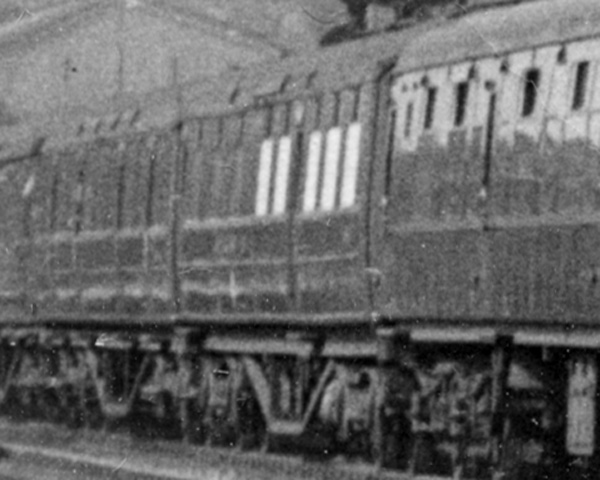
Here's an enlargement of the restaurant car and the TK beyond it.
For modellers it's obviously not a crack express with normal catering and while many reliefs did have normal catering, this one did not and is easier to model. I'm not a big fan of modelling rare formations and I haven't recognised such a formation before, but there we are. It can make a nice change.
Enter the RU
Renumbering of the ex-GNR 12w RCs (described below) freed up their previous numbers, which were promptly reused by the GN Section for new construction of a 1st class restaurant car (RF) and an unclassed restaurant car (RU):
1928 D.10C - RF - 43040 1929 D.11 - RU - 43041
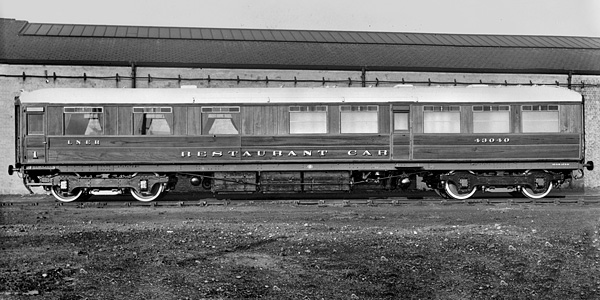
Here is the first one, No 43040 as built in 1928, reusing the now-vacant number. It was a normal 1st Class car (RF) with the classic arrangement of a large kitchen and 18 First class dining seats, the LNER's main line of development, followed by the very similar D.144 (hence the MJT and Kirk kits, respectively). They all ran paired with a 3rd Open Dining Car or Pantry 3rd.
Click on the image for an enlargement

The trade-off can be seen when increasing the number of catering seats: the kitchen was almost a yard smaller and the staff compartment was omitted. A supplementary Diagram was issued in 1934 showing 4-square toplights at the staff end of the carriage and steel-angle trussing. Both had electric cooking. There's an LNER-period official of one of the earlier builds lower down in this topic and some service notes under "Enter the RU". Diagram: Steve Banks collection.
Click on the image for an enlargement

And here, from 1929, is the second re-used number, 43041, as applied to the first unclassed restaurant car (RU) built to D.11. Note the smaller kitchen and much larger seating capacity of 30 seats, to run as a stand-alone restaurant car without a supporting dining car.
Click on the image for an enlargement
The background is that in 1929 the LNER started using unclassed restaurant cars for late-night trains when social niceties were less important, with the car placed on one end of the train for later evening meals, easily knocked off the rear at a stop along the way, or added in the morning to serve breakfast (see p.19 and p.160 for details of the down workings).
The complication is that Diagram 11 was built as both RU and RF. To be specific:
1929 RU 43041 1930 RF 31922/3 1931 RU 31924/6/35, 42783 1934 RF 31868/902 1934 RU 42782
To further complicate matters, some earlier RFs in the Diagram 10 series, D.10A and D.10C, were reconfigured as RUs, so they too began to contain a mixture of types. For modellers, the MJT kit can be built as an RU (No 21474).

A slightly later view from c1960 shows a rather mucky B16 61417 (YOR) leaving Scarborough. It's clearly a summer scene when reporting numbers were carried on the Scarborough line. It looks like the just after 10am departure of what used be called the "Scarborough Flyer" for King's Cross. A more powerful loco will take over at York. All the visible coaches are in maroon livery and still dominated by ex-LNER Gresleys. Most are on the later steel-angle trussing but the restaurant car is older. The leading carriages are shown below. Photo: B. Webb.
BCK |
1st/2nd brake |
61'6" Gresley |
SK |
2nd |
61'6" Gresley |
RF* |
1st restaurant* |
61'6" Gresley |
TSO |
2nd open |
BR Mk.1 |
TO |
2nd open |
61'6" Gresley |
TK |
2nd |
61'6" Gresley |
TSO |
2nd open |
BR Mk.1 |
... |
|
|
Rem. unclear |
||
* See notes below.
Click on the image for an enlargement
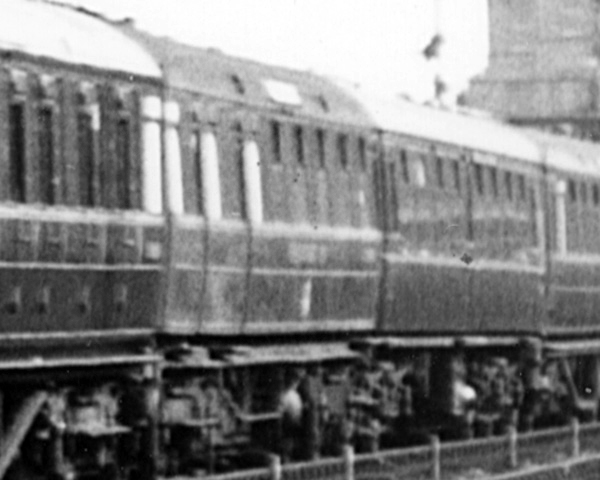
A closer view of the catering carriages shows that the Gresley restaurant car is supported by a BR Mk.1 TSO. Then it gets complicated for the restaurant car has five windows which identifies it as D.11 which was built 1929-31 on turnbuckle trussing, plus some more in 1934 which received steel-angle trussing. The real complication is that D.11 was built both as an RF and an RU (unclassed restaurant car), the latter to serve the LNER's sleeping car expresses. As the enlargement shows, it simply isn't possible to tell if there's a number "1" on the recessed far door and all that can be said is that it is D.11, whose Diagram I have reproduced below.
Click on the image for an enlargement
LNER Restaurant Composite
I hesitate to open this sub-section because this was quite an obscure type on the LNER. Before the Grouping the RC was common in the UK and on the more prosperous lines it tended to be a long carriage running on 6w bogies The GCR was an example in the lower leagues of passenger traffic, its approach fluctuated, and from 1911, modest 56ft and 60ft (RC,TO) pairs were built instead: Gresley quickly replaced them with (RF,TO) pairs and converted the RCs into Kitchen Cars for excursions - it's a separate story except for showing how the LNER dealt with this in England.
Apart from special requirements, the LNER focussed on Restaurant Triplet Sets and second-string pairings based on the 61'6" RF. The pre-Grouping RCs were used in less important services (or on the GC Section, eliminated) and the LNER saw no need to build any fresh ones never mind replacements until the mid- and late-1930s - when they were only provided for Scotland: the Southern Scottish Area and the Northern Scottish Area. Clive and I touched on this in Vol.1 and so did Michael Harris in "LNER Carriages" (1994/5 and rep. 2011). Two Diagrams were produced: D.187 (1934-6) and D.266 (1938), almost identical except for the kitchen side. They stayed in Scotland after Nationalisation.
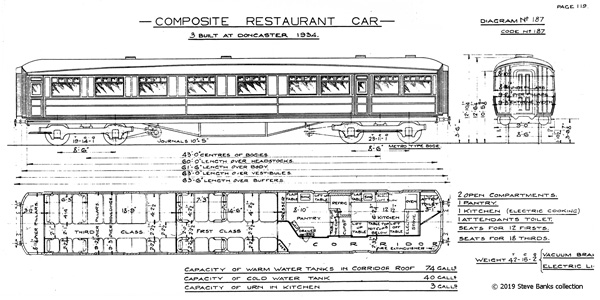
Diagram 187 was built in 1934-36. Note the 30-seat dining and much reduced kitchen area as a result. No staff compartment was provided, a throwback to pre-Grouping practice. Diagram: Author's collection.
Click on the image for an enlargement

A good view of an RC at Aberdeen, built to D.187 as No 32565 and by 1948, carrying its Thompson number 9159. The corridor side is seen, Photo: Peter Fidczuk Collection.
Click on the image for an enlargement
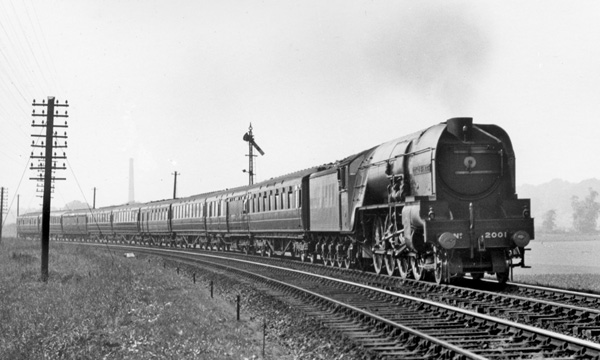
Relatively few of the RCs were marshalled inside an express formation. In this example between Edinburgh-Aberdeen, P2 No 2001 Cock o' the North is in charge with a D.187 RC placed between two TKs. Only one other carriage in the train offered 1st class seats: an FK behind the tender, three carriages away from the restaurant car. This was unlike services in England. Photo: Real Photographs.
Click on the image for an enlargement

Another example of an RC between Aberdeen and Edinburgh is seen at Princes Garden c1937 behind A3 No 2500 Windsor Lad. No 1st class seating can be identified at this end of the train nor immediately behind the RC. Photo: Photomatic.
Click on the image for an enlargement

Catering take-up was lower on the West Highland line and an RC was usually placed outside the main train where it could be attached and detached en route as required. In this case, seen in 1937 behind K2 No 4700 at Mallaig, the D.187 RC is behind the tender, outside the brake end. Photo: H.C. Casserley.
Click on the image for an enlargement
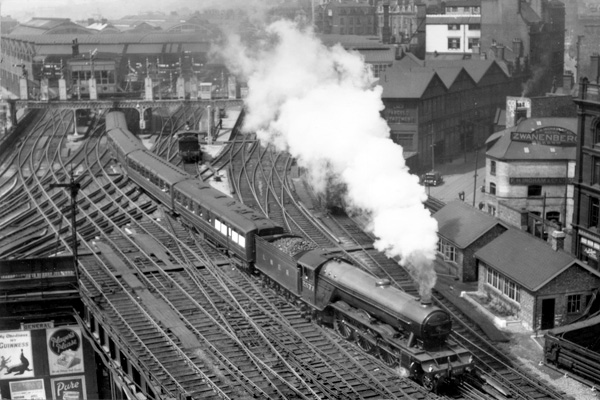
Some RCs were used between Edinburgh and Newcastle, again by attachment outside the main train. In this example, A1 No 2577 Night Hawk is leaving the east end of Newcastle for Scotland. A strengthening 3rd had been placed outside the brake end, and the RC outside that, next to the loco. For more details. see the next picture. Photo: Lens of Sutton.
Click on the image for an enlargement
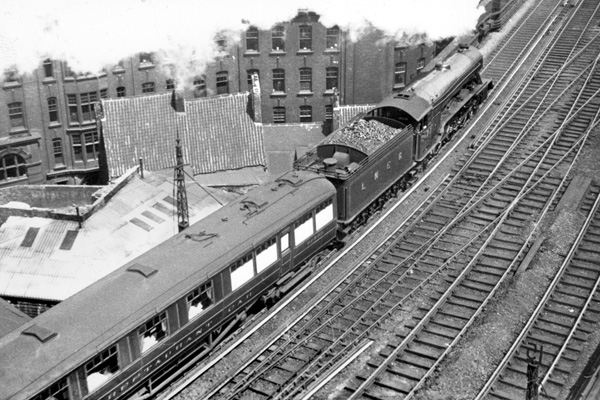
A going-away view of the same train showing a D.187, number 32535. Photo: Author's collection.
Click on the image for an enlargement
More about catering roofs
I've included this picture and a detail enlargement as an aid to modellers because views of the roof on a restaurant car tend to be rare.

Sometime in the late 1930s, Gresley A1 No 2577 Night Hawk, which was a North Eastern Area loco allocated to York from 1/37, leaves Newcastle with a down express. The date can be established as 1938-39 because of the D.266 restaurant car behind the tender, one of only four 61'6" restaurant composites, built only for the Scottish Area in 1938. Note how it was added for only part of the journey, outside the main formation. Photo: Lens of Sutton.
Click on the image for an enlargement
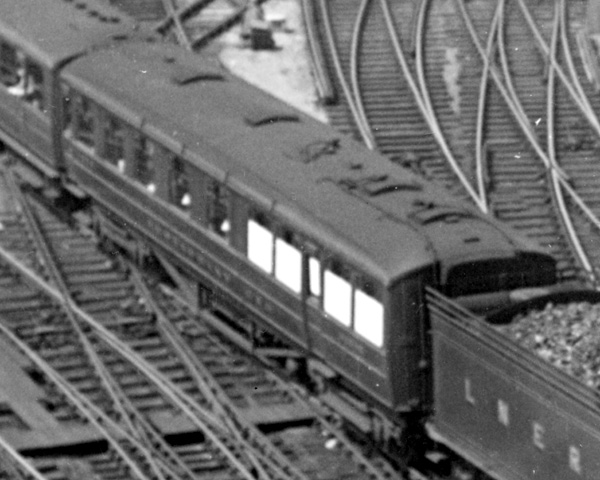
A detail view shows the roof fittings a little better, for anthracite-electric cooking, which was also fitted to the RFs and is thus helpful as a guide. I have sharpened the picture slightly. Photo: Lens of Sutton (detail).
Click on the image for an enlargement
Another example showing the roof and its plumbing on an anthracite-electric restaurant car.

Seen at Newcastle behind A1 No 2577 Night hawk is a Scottish Area RC to D.187, No 32535. The principal fittings were the same on the anthracite-electric RF. Note how the restaurant car was an addition to the train and placed behind the tender. Photo: Author's collection.
Click on the image for an enlargement
Some modelling thoughts
This is not the place to dwell on the modelling side but looking at the vehicle history has led to some interesting developments.

A general view of a D.10C Restaurant 1st from the MJT kit, finished in BR maroon livery. It's an impressive vehicle with a lot of detail and written up in one of the magazines (see the Articles index).
Click on the image for an enlargement

A closer view of the dining saloon (to use the same term as the LNER). The quality of the MJT etchings is fabulous and you can have so much fun with the interior. I scored the Stones vents onto the glazing.
Click on the image for an enlargement

Click on the image for an enlargement
The Kirk kit is for the D.144 version with recessed doors and I fitted it with the later steel angle trussing. I've learned more about the LNER RF since making this model and one thing I am not sure about is the moulding for the body sides which were based on Nick Campling's drawing in HCD-1 for the very same numbered carriage as built in 1934. The single LNER photo only showed the corridor side - with the long-standing, shallow Stones vents (which in the plastic moulding are somewhat approximate) at the dining saloon, and along the corridor, deep 4-square sliding vents.
There are no known photographs of the kitchen side (seen here on the kit/model) and it looks like Nick was forced to estimate what had been there and he plumped for the deep square sliding ones, same as on the corridor side. The trouble is that there are still no known pictures for this side from 1934, but several from the years either side - and they show ventilator bonnets still being fitted over the kitchen windows. Later pictures then show:
1935 - a two-stage change. At first the bonnets were retained but the dining saloon was improved with much deeper Stones vents. Later in the year there was another development, keeping the deeper Stones vents but doing away with the bonnets over the kitchen windows and fitting square sliding vents.
1936 - was the final year of construction and this time the kitchen vents were left alone (square sliding) while in the the dining saloon, Stones vents were finally abandoned and large conventional square sliding vents were fitted.
In this light it would appear that Nick's estimate for the kitchen side in 1934 was never actually built. The drawing and model should have ventilator bonnets over the kitchen windows made by filling with Plastikard and attaching the MJT castings.
Casting an eye over this, it's evident that the Kirk kit can be made into a realistic model of any of the builds from 1931-36, by choosing which ventilators on the body you are going to modify. You can also have the earlier trussing (fitted in the first year). Plastic kits do lend themselves to customising like this!
In summing up, there are two points here, the first being that the pace of development increased while D.144 was being built in the years 1934-36. And that as I pen these notes, there aren't yet enough photographs to be definite about every step in the process at that time. I shall keep trying to collect fresh photographs and any help from readers would be welcome, please.
From 12w GNR RC to LNER/BR RK - rebuilding and renumbering
- A key aspect of the LNER was that the Areas and Sections were responsible for their own carriage fleets and the first digit of the running numbers was used to indicate the ownership. For example, "2" was for the NE Area, "3" the South Scottish Area, and "4" the GN Section. When a carriage was transferred, the whole number was changed, leading with the requisite digit. A great deal of the running numbers were random, and when gaps were created by transfer or scrapping, they could be reused.
- A further aspect was that Diagrams were not as exclusive as many people think: some of them held groups of types. Combine all this and you'll see that a running number alone, or a Diagram number, can be misleading - you needed the date as well, and hopefully, a reliable source.
This particular saga began in 1906 when the GNR built three 65'6" Restaurant Composites as part of the "Sheffield" stock. The general coaches were 8-wheel, but the catering coaches, including this trio, were 12-wheel. After the LNER was formed in 1924, they were renumbered : 43039, 43040, 43041.
They were being replaced in top flight expresses on the GN Section and were cascaded to lesser services in the NE Area and South Scottish Area, and renumbered again, as : 22262 and 32302,32303.
On receipt of 43039, the NEA put it in one of the cross-country expresses, the Newcastle-Bournemouth (which isn't hard to model if you pick the right part of the journey), and the GN Section number was retained for quite a few years. When, or even if, it was renumbered I cannot say.

I haven't a prototype picture of 43039 but, as the saying goes, here is one I made earlier, from the D&S kit. This is the corridor side.
Click on the image for an enlargement

And here is the kitchen side.
Click on the image for an enlargement
Around 1936 all three of the ex-GNR 12w Restaurant Composites were rebuilt as Kitchen Cars for use in guaranteed excursions. The underframe fittings were revised vis a vis the cooking requirements, and the trussing was changed from turnbuckle to steel angle, but the 6w bogies were retained. The first one, formerly the car known as 43039, supposedly 22262, remained allocated to the NE Area and it was joined by the other two which, with renumbering, became: 22262, 2334, 2335.
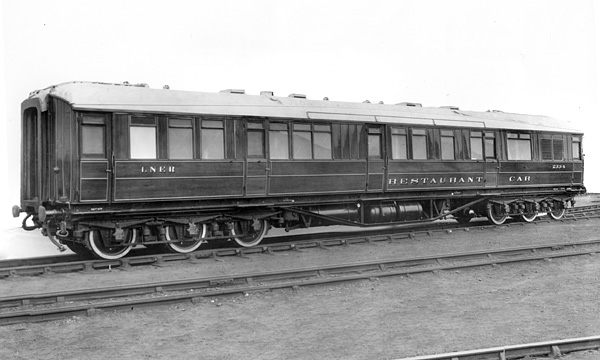
This is an official view of the rebuild of RC 43040 into RK 2334. From the kitchen side you can see how the former dining areas were utilised with a staff compartment and toilet at this end, and at the far end, an extra pantry with ventilation grilles and a door for loading. Note the large cylinders for gas cooking.
The branding "Restaurant Car" may be yet another confusing factor and it may look anomalous but it was for public consumption and perfectly straightforward - the LNER applied it across the board to all its kitchen, restaurant and dining cars to indicate that full meals were available on the train, and where of course. Only the Buffet Cars had dedicated branding at a lower level.
Need any more confusion? When not enough buffet cars for buffet excursions could be found, a restaurant car would be inserted, but as would have been stated on the handbill, only a buffet service was provided. Catering carriages were always in demand - and prone to breakdown because of the cooking equipment - so the company held quite a large pool of them. It was rare for the same catering coach to complete a whole season in the same service and replacements weren't always like for like. For example, an RF could be replaced by RK+FO(dining).
Click on the image for an enlargement

Many years later, in 1956, the rebuild of RC 43039 to RK E22262E was captured at Heaton. The corridor side had not been changed, which means that an enterprising modeller could produce an RK from the D&S kit by modifying the other side, and updating the underframe. As can be seen, BR adopted external branding of "Kitchen Car".
Click on the image for an enlargement

Another picture has come to light of the three ex-GNR 12w RC to GN.60, one of which was used in the LNER Newcastle-Bournemouth, until converted into kitchen cars (RK) for use with guaranteed excursions. There is much confusion in this area, notably by Longworth, and this one is believed to have been GN 3040 then LNER 43040 and as an RK, 2334, and is finally seen in BR maroon livery E23202E lasting until 11/60. Photo: author's collection.
Click on the image for an enlargement
The restaurant triplet sets, general, "Flying Scotsman" and streamliners: are here.

